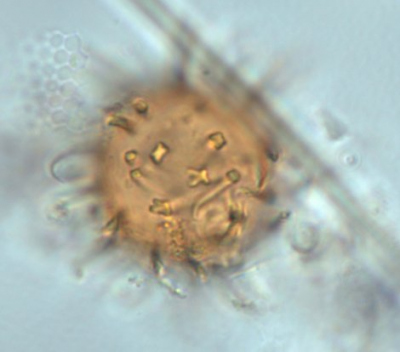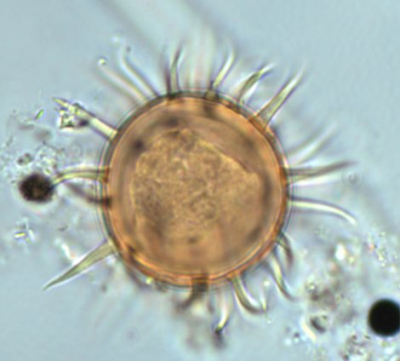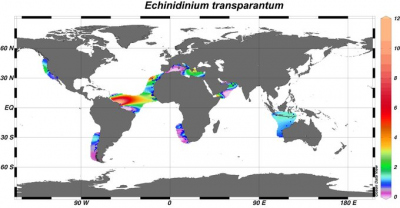Page path:
- Modern Dinocyst Key
- brown cysts
- spherical brown randomly distributed processes
- spherical brown cysts with solid processes
- Echinidinium transparantum
Echinidinium transparantum
Zonneveld, K.A.F. and Pospelova V. (2015). A determination key for modern dinoflagellate cysts. Palynology 39 (3), 387- 409.

lateral view Holotype
photo by Karin Zonneveld
photo by Karin Zonneveld

cross section Holotype
photo by Karin Zonneveld

lateral view
photo by Karin Zonneveld
Field characteristics
Echinidinium transparantum Zonneveld 1997
Characteristics:
Spheroidal brown cysts covered with many randomly and regularly distributed spines. Cyst wall is formed by a smooth pedium and a smooth luxuria forming the solid, acuminate spines. The spines are rigid and transparent. Their distal ends are sharply pointed. The outline of the spine bases is (sub) sphaerical to unregularly rectangular. The colour of the processes can vary between transparent to yellowish brown. The chasmic Archeopyle consists of a split, probably along a single suture. No other tabulation is observed.
Dimensions: body diameter 22-36 μm (mean = 28.7 μm); process length 5-14 μm (mean = 9.5 μm), base spines 1.5-2.5 μm (mean 2 μm).
Motile affinity: unknown
Stratigraphic range: recent
Comparison with other species:
The characteristic feature of this species is the presence of solid processes that have bases that are spherical to unregularly rectangular. The species most closely resembles Echinidinium zonneveldii but it differs from this species in having regularly distributed processes of equivalent length.
Characteristics:
Spheroidal brown cysts covered with many randomly and regularly distributed spines. Cyst wall is formed by a smooth pedium and a smooth luxuria forming the solid, acuminate spines. The spines are rigid and transparent. Their distal ends are sharply pointed. The outline of the spine bases is (sub) sphaerical to unregularly rectangular. The colour of the processes can vary between transparent to yellowish brown. The chasmic Archeopyle consists of a split, probably along a single suture. No other tabulation is observed.
Dimensions: body diameter 22-36 μm (mean = 28.7 μm); process length 5-14 μm (mean = 9.5 μm), base spines 1.5-2.5 μm (mean 2 μm).
Motile affinity: unknown
Stratigraphic range: recent
Comparison with other species:
The characteristic feature of this species is the presence of solid processes that have bases that are spherical to unregularly rectangular. The species most closely resembles Echinidinium zonneveldii but it differs from this species in having regularly distributed processes of equivalent length.
Geographic distribution
Geographic distribution based on :
Zonneveld et al., 2013. Atlas of modern dinoflagellate cyst distribution based on 2405 datapoints. Review of Palaeobotany and Palynology, v. 191, 1-197
E. transparantum is a tropical to subtropical species that is typically present in upwelling regions or regions influenced by river discharge. These regions are oligotrophic to eutrophic with anoxic to well ventilated bottom waters.
Zonneveld et al., 2013. Atlas of modern dinoflagellate cyst distribution based on 2405 datapoints. Review of Palaeobotany and Palynology, v. 191, 1-197
E. transparantum is a tropical to subtropical species that is typically present in upwelling regions or regions influenced by river discharge. These regions are oligotrophic to eutrophic with anoxic to well ventilated bottom waters.

Distribution:
E. transparantum is observed in subtropical to tropical coastal regions and upwelling areas of the North and South Eastern Pacific, North and South Atlantic Ocean, the Mediterranean Sea, the Arabian Sea and the southeastern Indian Ocean with enhanced upper water productivity. Highest abundances up to 11% occur in the Amazon River discharge area, off NW Africa and in the eastern Mediterranean Sea.
Environmental parameter range:
SST: 8.5 - 29.8°C (winter - summer) and exceed 10.3°C in summer. Exception is formed by two site in the northeastern Pacific with SST: -1.3, -0.8, 4.4 and -0.8°C (winter, spring, summer, autumn) and 6.3°C. SSS: 31.0 - 39.2 (winter - autumn) except for two sites where SSS is reduced to 19.6. [P]: 0.1 - 1.2 μmol/l, [N]: 0.2 - 13.1 μmol/l, chlorophyll-a: 0.14 - 16.7 ml/l, bottom water [O2]: 0 - 6.1 ml/l.
Comparison with other records:
So far Echinidnium transparantum not been registered from regions other than those covered by this Atlas. Cysts are produced during active upwelling in the Arabian Sea (Zonneveld and Brummer, 2000)
E. transparantum is observed in subtropical to tropical coastal regions and upwelling areas of the North and South Eastern Pacific, North and South Atlantic Ocean, the Mediterranean Sea, the Arabian Sea and the southeastern Indian Ocean with enhanced upper water productivity. Highest abundances up to 11% occur in the Amazon River discharge area, off NW Africa and in the eastern Mediterranean Sea.
Environmental parameter range:
SST: 8.5 - 29.8°C (winter - summer) and exceed 10.3°C in summer. Exception is formed by two site in the northeastern Pacific with SST: -1.3, -0.8, 4.4 and -0.8°C (winter, spring, summer, autumn) and 6.3°C. SSS: 31.0 - 39.2 (winter - autumn) except for two sites where SSS is reduced to 19.6. [P]: 0.1 - 1.2 μmol/l, [N]: 0.2 - 13.1 μmol/l, chlorophyll-a: 0.14 - 16.7 ml/l, bottom water [O2]: 0 - 6.1 ml/l.
Comparison with other records:
So far Echinidnium transparantum not been registered from regions other than those covered by this Atlas. Cysts are produced during active upwelling in the Arabian Sea (Zonneveld and Brummer, 2000)


